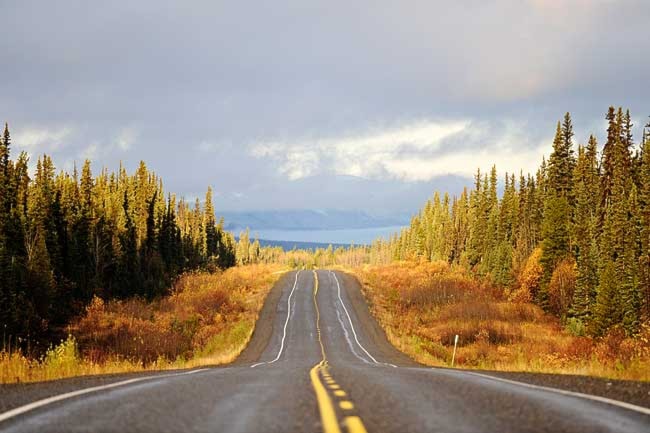The territory’s acclaimed assessment regime will not be used for what could be the biggest industrial project to cut through the Yukon.
The federal government announced its decision that the proposed Alaska Highway pipeline project will not be assessed by the Yukon Environmental and Socio-economic Assessment Board during a regulatory workshop late last week.
The meeting marked the beginning of three months that the territory, First Nations and other federal departments have to give input on how the Northern Pipeline Agency sets up the environmental and socio-economic regulatory regime for the project.
A lot of that time will be spent making sure the conditions for TransCanada, the company proposing to build and use the pipeline, include aspects that have changed since the original National Energy Board certificates were granted in the 1970s.
Aspects like aboriginal self-governance.
“They’re just really working to push this project through,” said Kluane First Nation Chief Math’ieya Alatini. “Our timeline is really short.
“But it’s up to the First Nations to step up to the plate and say, ‘This is what we expect.’ We need to stand up for ourselves.”
But First Nations already feel the process is cutting corners with aboriginal consultation.
Most notably, the advisory councils that will be tasked to review and update the project’s terms and conditions have dropped from the possible 10 members mentioned in the Northern Pipeline Agency’s Act to three members.
Three council members will represent federal, territorial/provincial and aboriginal interests equally, said Christopher Cuddy, executive director of external relations for the agency.
But the pipeline will affect at least 40 First Nations across the Yukon and B.C.
Twenty-two per cent of it will cut through Yukon First Nations’ settlement lands.
“But the number three is not fixed,” Cuddy added.
The territory’s aboriginal groups have a lot of questions about the project, Alatini said.
The proposed pipeline would cut through the entirety of her First Nation’s traditional territory, including five kilometres underneath Kluane Lake.
None of their questions were answered at last week’s meetings, she said.
Yukon chiefs have requested a meeting with Joe Oliver, the minister of Natural Resources Canada, which is responsible for the Northern Pipeline Agency. They are in Ottawa for an Assembly of First Nations chief assembly this week.
“We have to be able to get on this now,” said Alatini. “It will take, maximum, two years to construct the entire pipeline. They can put in just over two to four kilometres of pipe per day.
“It’s an eye-opening experience and it’s going fast and furious. And I think Yukoners really need to be aware of this.”
The federal government has scheduled 15 months to update and review the agency’s environmental and socio-economic assessment regime once the advisory councils are established.
“The federal process outlined is based on the status of the project,” said Cuddy. “You have to understand this is a project with a long history. It is an existing project. The project has been approved by a federal statute. And part of the pipeline has been built.”
In the early 1980s, pipeline was constructed in B.C., Saskatchewan and Alberta. An easement through the Yukon was granted in 1976, renewed in 1987 and 1992, and is set to expire on September 20, 2012. Nothing has been built in the territory yet.
TransCanada has just requested the 760-kilometre-long and 240-metre-wide right-of-way through the Yukon be renewed again, for another 10 years. In the 2011 federal budget, Canada committed $4 million to the project over the next two years.
“The project has got to the point where we need to lay out a regulatory plan,” said Cuddy. “And First Nations and others have been asking for it.”
Even though the Yukon Environmental and Socio-economic Assessment Act has provisions to allow its board to assess existing projects, the federal decision to look at this project itself is not intended to undermine the territory’s capabilities nor First Nations’ final agreements that the Yukon’s act was developed from, Cuddy added.
“We’re in discussion with First Nations on how to do it,” Cuddy said. “We’ve been pretty careful. We’re pretty conscious about putting out a process that is respectful of those self-governing First Nations in Yukon in particular.”
But the Yukon’s assessment board still has some questions for the federal government.
Most notably, there will need to be temporary and permanent access routes, like roads, built to the pipeline, said YESAB chair Stephen Mills.
“Because they have not been assessed with the project previously, what is the mechanism for them to be assessed and regulated?” he asked, adding that the question was raised at last week’s meeting but was not answered.
“Overall, those are some of the aspects that are still outstanding. But I think the Northern Pipeline Agency has made it clear what are their steps forward on the significant aspects of the project.”
A final decision on whether the pipeline will become reality is scheduled for 2014, said Cuddy.
If it does, it has the potential to produce $70 million to $100 million of tax money to the territory each year, said Ron Sumanik, acting director of oil and gas resources with the territory’s Department of Energy, Mines and Resources.
It will take some “modernization” of the Yukon’s taxation laws, and the territory has to negotiate with First Nations on how that revenue will be shared, Sumanik added.
There are other options the territory is also exploring to maximize the potential benefits from this project, he added.
“This thing is ramping up,” he said. “And the devil is in the details.”
Contact Roxanne Stasyszyn at
roxannes@yukon-news.com
